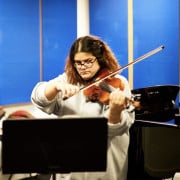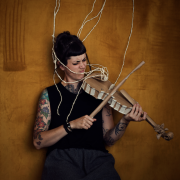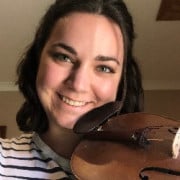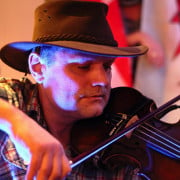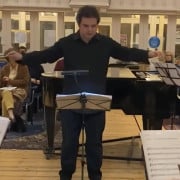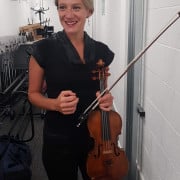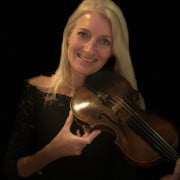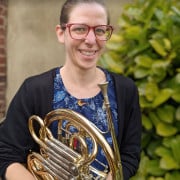Violin teachers in Birmingham
-
Rhiannon 4.9 (10)
Online only
Violin, Music Theory, A-Level Teacher, GCSE Teacher
-
-
-
-
-
-
-
-
-
-
-
-
Want more options?
Expand your search criteria or scroll down to see teachers who offer online tuition.
Online teachers in violin
Location doesn't matter when you choose to learn online and you can start right away.
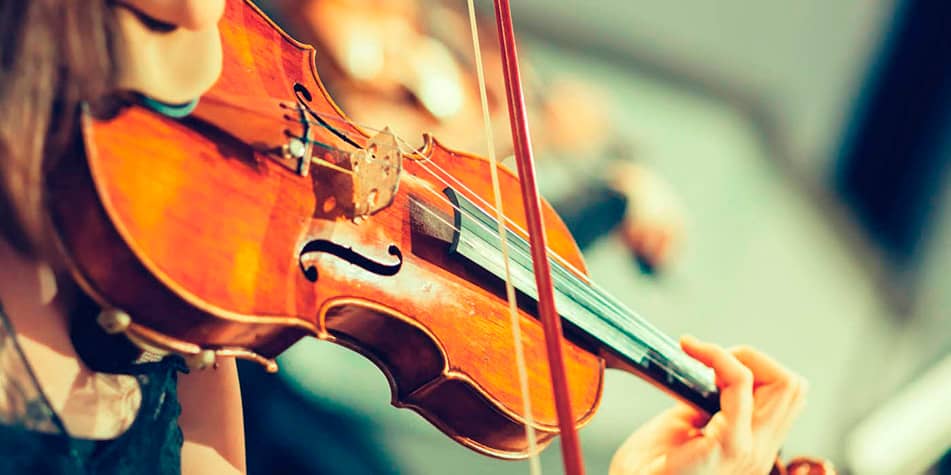
Want to Learn to Play the Violin? Take Violin Lessons!
Want to start learning violin? Living in Birmingham? Want to be able to play timeless pieces by composers such as Mozart or Paganini? You need some violin lessons in Birmingham! Why not get in contact with one of our professional violin teachers today! Wherever you are in your playing, whatever your specific need for violin lessons in Birmingham - whether violin lessons for the beginner, or violin lessons for the intermediate or advanced player, we can match you with the perfect violin teacher and have you making progress in no time in your violin lessons in Birmingham!
Professional, Trusted Violin Lessons in Birmingham!
At MusicTutors, we ensure that as you learn to play the violin, all of our violin lessons in Birmingham are taught by teachers with an Enhanced DBS Certificate as well as sharing our vision for a regulated online music tuition platform. Safeguarding and child protection are issues very close to our hearts and we are committed to supplying high quality, safe violin lessons in Birmingham, accessible to all.
The Benefits of Taking Violin Lessons in Birmingham
Imagine playing Caprice 24 confidently, in front of an audience. You've learnt the piece in your violin lessons in Birmingham and practised at home and taken it to the stage! The audience burst into applause. How great does that feel? Good for your confidence, self-esteem and great motivation to continue to take violin lessons in Birmingham. A performance like this takes many hours of practise and hard work - our violin teachers can help with exactly that. Whether you want violin lessons in Birmingham to learn the basics or you want violin lessons as an advanced player in search of new challenges, one of our expert violin teachers can help you. For children, taking violin lessons in Birmingham is a great idea - it's really good for developing co-ordination, concentration, focus and confidence. What are you waiting for? Message one of our violin tutors today for 50% off the first of your violin lessons in Birmingham!
Violin Lessons in Birmingham Not for You?
MusicTutors doesn't just offer amazing violin lessons in Birmingham. Our tutor base covers the whole of the UK!
- Violin Lessons in Leeds
- Violin Lessons in London
- Violin Lessons in Bristol
- Violin Lessons in Manchester
Other Lessons in Birmingham
MusicTutors doesn't just offer violin lessons in Birmingham. We also provide music lessons in a wide range of other instruments.
Our Customers Love MusicTutors
"Great service and experienced instructors!!"
5 out of 5
Despina Sotireli - Student at Musictutors.co.uk
Getting to Know the Instrument Before Your Violin Lessons in Birmingham
Before starting your violin lessons in Birmingham, it's helpful to know a bit about which part does what! Here's a bit of info to get you started...

- Scroll: the scroll sits at the top of the violin and is purely for decorative purposes!
- Pegs: these are used to tune the strings - each peg has one of the strings threaded through it. If you tighten the string, it will sound sharper, and if you loosen it, it will flatten. When you first start to play the violin, ask your violin teacher to help you in your volin lessons as it's an iportnat but tricky skill to master.
- Neck: the neck of the violin is where your left hand will be. In your violin lessons, your violin teacher will give you exercises and pieces that will help you improve the left hand as you learn to play the violin.
- Fingerboard: this is where you put your fingers to make different notes sound. Getting the right amount of pressure on the fingerboard is one of the key skills to master as you learn to play the violin. Expect a good proportion of you time in violin lessons to be spent on this!
- Body: the body of the violin is hollow, and that's where the sound is made. Inside the body is a sound peg - this supports the body and can also alter the sound when adjusted. Your violin teacher will be able to check that your violin is set up correctly in your violin lessons.
- Strings: the lowest string, which is the one nearest your face and shoulders, is a G. The next string up is D, then A, then E. Try and think of a way of memorising this, maybe a four-word sentence, with each word starting with the string letters - for example, Good Dinosaurs Ate Eggs. It can be as silly as you like, as long as it helps you remember the string names! Violin teachers usually have a wealth of such phrases they will be more than happy to share with you in your violin lessons. Between the end of the fingerboard (nearest to your face) and the tailpiece is where you typically use your bow, though some more advanced techniques may involve bowing over the fingerboard or closer to the bridge. It's important to replace your strings regularly, especially when you first learn to play the violin and you are practicing a lot. Ask your violin teacher for advice on this, and watch an expert change the strings, perhaps in your violin lessons before you attempt it yourself - it's not as easy as you might think!
- F-Holes: these holes are vital projecting the sound from the body.
- Bridge: the bridge props the strings up. It should sit so it's completely straight, at a 90 degree angle from the body.
- Fine-Tuners: most beginner violins will have 4 fine-tuners, one for each string. These are really helpful as you learn to play the violin as for those less experienced with tuning the violin, they're much easier to work with than the tuning pegs and help to get perfectly in-tune strings. More advanced players often use violins with only 1 fine-tuner for the E string, as fine tuners can effect the tone of your violin and more advanced players are more experienced with the tuning pegs.
- Tailpiece: the tailpiece hooks onto the top end of the violin, by the chin rest. It holds the end of the strings and keeps them taut.
- Chin Rest: as suggested by the name, this is where you rest your chin! Ask your violin teacher for advice on positioning in your violin lessons. Some players play without chin rests, some choose different designs of chin rests, and some cover the chin rest with material to make it more comfortable. It's all about preference and what feels comfortable for you - we're all built differently!
- Stick of the Bow: this is the wooden part of the bow. It's important to make sure the stick is not too tight or loose when playing - you can alter the tightness with the screw on the end of the frog. If it's too tight, it could snap, and if it's too loose, you won't get a clean sound. ALways ask your violin teacher to check thid in your violin lessons. LEarn to play the violin and after some time, more advanced bow techniques involve using the wood to play the strings - this is often used as an effect in orchestal pieces.
- Tip of the Bow: it's important to explore playing with the full bow, from the frog to the tip, as it's easy to get stuck in the middle of the bow where it's easiest to control the sound. Your violin teacher will be able to give you some exercises to improve bow control as you learn to play the violin.
- Hair of the Bow: this is the part of the bow you use to play the strings. It's important to get the bow hairs replaced every so often - certainly not as regularly as the strings on the violin, but every year or two you'll notice the hairs have diminished and worn down from the application rosin and playing, both in your violin lessons and practicing at home and with ensembles.
- Frog of the Bow: this is where your right hand will go. It's also where you can alter the tightness of the bow hairs.
Do I Need My Own Instrument for Violin Lessons in Birmingham?
It's important that you have access to a violin to practise on between violin lessons in Birmingham. We would recommend doing some research and asking your violin teacher in your violin lessons in Birmingham for advice. Buying a violin is very personal, and you need to find one with a sound that you love, but it's also worth considering it as an investment. You can also ask for advice from music shops or dealers, but it's important to remember that they aren't always impartial - they make a profit if they can convince you to buy their products, and there's no guarantee of quality or condition! It can also be helpful to get advice from a luthier who makes and repairs violins - they tend to be very knowledgeable about different makes of violin, what they're worth at certain ages etc. Unlike the market of many instruments, second hand violins can actually be much more expensive and can be better quality. However, don't get caught up in the age of an instrument if you don't know anything about the make or the quality - an old violin isn't necessarily a good violin. Most importantly, when you learn to play the violin, it should be an enjoyable experience. Choosing the right instrument, both for your violin lessons and for practice at home is an important decision not to be rushed or taken lightly!
Here are some shops to look at:
What Size Violin Do I Need for My Violin Lessons in Birmingham?
The violin comes in full size, 7/8, 3/4, 1/2, 1/4, 1/8, 1/10, and 1/16 sizes. The smaller sizes (3/4 and below) are generally only used for children in violin lessons, and rarely produce the same quality of tone as a bigger violin. 7/8 and full size are both mainly used by adults and children 12 and up who are learning to play the violin, depending on their size. Most adult players choose to play full size violins but some feel more comfortable with a 7/8 size violin. The body length (without neck) of an ordinary violin is about 35 cm. A 3/4 violin is about 33 cm and a 1/2 violin is about 30 cm. Be careful as sizes vary between manufacturers. Size is all about what's comfortable for the player, so find one that works for you. For parents, it's worth considering how much money you spend on a smaller violin for your child - bear in mind that they will grow and you'll likely have to buy a bigger size at some point! Your violin teacher will help recommend a size for your violin lessons in Birmingham.
Useful Equipment for Violin Lessons in Birmingham
Aside from a violin and bow, you will need:
- A shoulder rest - this attaches to the bottom of your violin and rests on your shoulder, lifting your violin up to your chin. Your violin teacher may supply you with a sponge or something similar in the beginning as you learn to play the violin to save on costs, but eventually you will most likely need a shoulder rest for your violin lessons. Some players prefer to play without one, but most use a rest. If you can, try out a few different rests in your violin lessons and see what's comfortable for you.
- Rosin - this is what you put on the bow hairs to improve tone and grip. Your violin teacher can advise you on a good brand in your violin lessons.
- A case for your violin - this is important to keep your violin safe and allow you to travel with it as your learn to play the violin. Your violin teacher can advise you on an appropriate case, but most will recommend a good quality solid case (Hiscox is a good brand for this, though quite expensive) for travelling any distance.
- A music stand - it will be helpful to have a music stand at home for practice!
Playing the Violin
When you first start to learn to play the violin and see the fingerboard, with no markings or frets, it can seem overwhelming. How do you know where the notes are? This is something you will soon get used to in your violin lessons. Many violin teachers, when working with beginners, will put a couple of stickers on your fingerboard temporarily, just to help you find your way around. After a few violin lessons in Birmingham you won't need them and will naturally find the notes on your own, both in your violin lessons and even when practicing at home.
When you first start violin lessons in Birmingham, it's really important to be mindful of your technique. Like learning any other instrument, technique is the backbone of everything you do and learn, and it's especially important when you learn to play the violin. In some instruments, technique is mostly there to protect you from injury, it doesn't necessarily effect the sound you're making in a huge way. When you learn to play the violin, this is not the case. Of course, it's still there to protect you from injury, but it also dictates how good your sound is. Good bow technique is vital for successfully using different articulations in your playing, and creating great tone. Likewise, good left hand technique dictates how well your notes sound and how good your intonation is. In your violin lessons in Birmingham, you can expect your violin teacher to give good, clear instruction on the best way to produce good tone as you learn to play the violin.
The best way to learn great violin technique is from great violin lessons in Birmingham, but here are some tips to consider as a starting point when you learn to play the violin:
- Before picking up the bow in your violin lessons in Birmingham, try to really relax your wrist and hand. Give it a shake, open and close your fingers, rotate your wrist in a circle. This will help you keep your joints relaxed so they can flow with your bow movement - you never want to have any of your joints stiff or locked when you learn to play the violin.
- When attempting bow hold, keep your hand relaxed and place it gently on the bottom end of the bow. From here, while maintaining relaxed joints, shuffle your fingers into place: your thumb should gently tuck under the stick of the bow and neatly rest by the frog; the middle joint of your first finger should rest on the stick of the bow, with your finger curved; the ends of your middle and ring fingers should rest on the side of the frog; the tip of your little finger should sit on the stick of the bow, without being stiff. Watch how your violin teacher does this in your violin lessons.
- Your left hand should always be relaxed, and again, no joints should lock or be stiff. Your fingers should all be able to comfortably sit on the fingerboard; your thumb should rest on the side of the fingerboard; your wrist should be relatively straight.
- A common mistake made by beginners who learn to play the violin, is having the wrist bent and the hand flat under the neck of the violin in their violin lessons. This will not only make your wrist ache but limits movement in your fingers and hand - when you are more advanced, you will need to move your hand up and down the fingerboard to reach higher notes, and you can't make these movements smooth if you're gripping the neck with your hand. Make sure your wrist is relaxed, not bent, and nowhere near the neck of the violin in your violin lessons in Birmingham.
Posture in Violin Lessons in Birmingham
It's possible to play the violin whilst sitting or standing. For example, if you were doing a solo performance, you would stand, but in ensembles such as string quartets or orchestras, you would most likely be seated. In both cases, and also in your violin lessons or for practice at home, it's very important that you pay great attention to your posture. Sloppy posture can result in aches, pains and over time, more serious conditions such as repetitive strain injury. When you lern to play the violin it feels at first an unnatural position for the body. In your violin lessons, your focus should be on making your posture as natural and relaxed as possible. In order to master the principles of a secure and relaxed posture, it's recommended that you seek the advice of an expert violin teacher and take some violin lessons in Birmingham.
Warm up Exercises
Enhance your awareness of intonation and finger placement by using a daily schedule of etudes, scales and long notes. Your violin teacher will give you a repertoire of such activities, in ever increasing complexity as you learn to play the violin. Such exercises are a vital component of improving your skills as a violinist - both solo and in an ensemble. There are a multitude of great warm-up exercises to improve technique and dexterity in both hands. Worth a special mention are Ševčík's violin studies, which focus on the right and left hand individually. These can especially help to increase the strength of the fingers, so fast play and double stops become more achievable in your violin lessons in Birmingham.
Reading Music for Violin Lessons in Birmingham

Depending on what genre you choose to pursue, reading music can be a vital part of your playing - and even if you choose to pursue a genre in which you don't use sheet music, it's still a great skill to have! Your violin teacher will most likely cover reading music with you in your violin lessons in Birmingham, but here are a couple of useful points to get you started:
The set of five lines on sheet music is called the stave. Music always begins with a clef - this is important as it dictates what the different lines and spaces in the stave mean. The violin uses treble clef, so let's concentrate on that!
In the treble clef, the lines from bottom to top are:
E
G
B
D
F
Again, you might find it helpful to make up a rhyme to remember this. A commonly used one is:
Every
Good
Boy
Deserves
Football
The spaces between the lines represent another set of notes. From bottom to top they are:
F
A
C
E
You can remember this one as it spells "face"!
Eventually, when you look at a piece of music, you will be able to hear the melody in your head, and play it straight away! This takes a lot of practice and ear training but it's super rewarding!
Using a Metronome
Playing in time an essential skill for any musician. Although very difficult when you first start to learn to play the violin, if we start at the earlier stages of our playing it will save hours of frustration in our violin lessons in the future. To do this, we practice in time with a metronome, a device that makes infinite audible clicks. These clicks each represent one beat in the bar. So for one bar of 4/4, we set the metronome at an appropriate tempo (best to start slow and build up!) and count with each beat. Once you’ve internalised this from counting along, you can start to play along with the metronome. One good tip is for your violin teacher to play alongside or count with you in your violin lessons in Birmingham before taking this away and practicing at home on your own.
Music in Birmingham
Being one of the biggest cities in the country, it is no surprise that Birmingham has had and still has a thriving music scene. Several famous bands have come out of the city such as Electric Light Orchestra, Dexys Midnight Runners, The Moody Blues, UB40 just to name a few. Birmingham also boasts many different music venues, some of which are small and some of which hold several thousand people. With venues like Resorts World Arena, Arena Birmingham, O2 Academy, The Institute, and Hare & Hounds, among many others, Birmingham has got the music scene covered. If you're dreaming of performing here, MusicTutors.co.uk can help! We are here to help you further your playing and no matter your level we have the teacher for you.

Questions About Violin Lessons in Birmingham?
At MusicTutors, we love helping connect students with their perfect tutor. If you have any questions about violin lessons in Birmingham, don't hesitate to get in touch. The office team are all professional musicians and educators and we love giving great service. Simply call 07946125613 or send us a mail to [email protected]. We look forward to hearing from you!
Do You Want to Be a Music Tutor at MusicTutors.co.uk?
We are always looking for talented music tutors all over the UK. Think you're the right person for the job?
Apply here!

